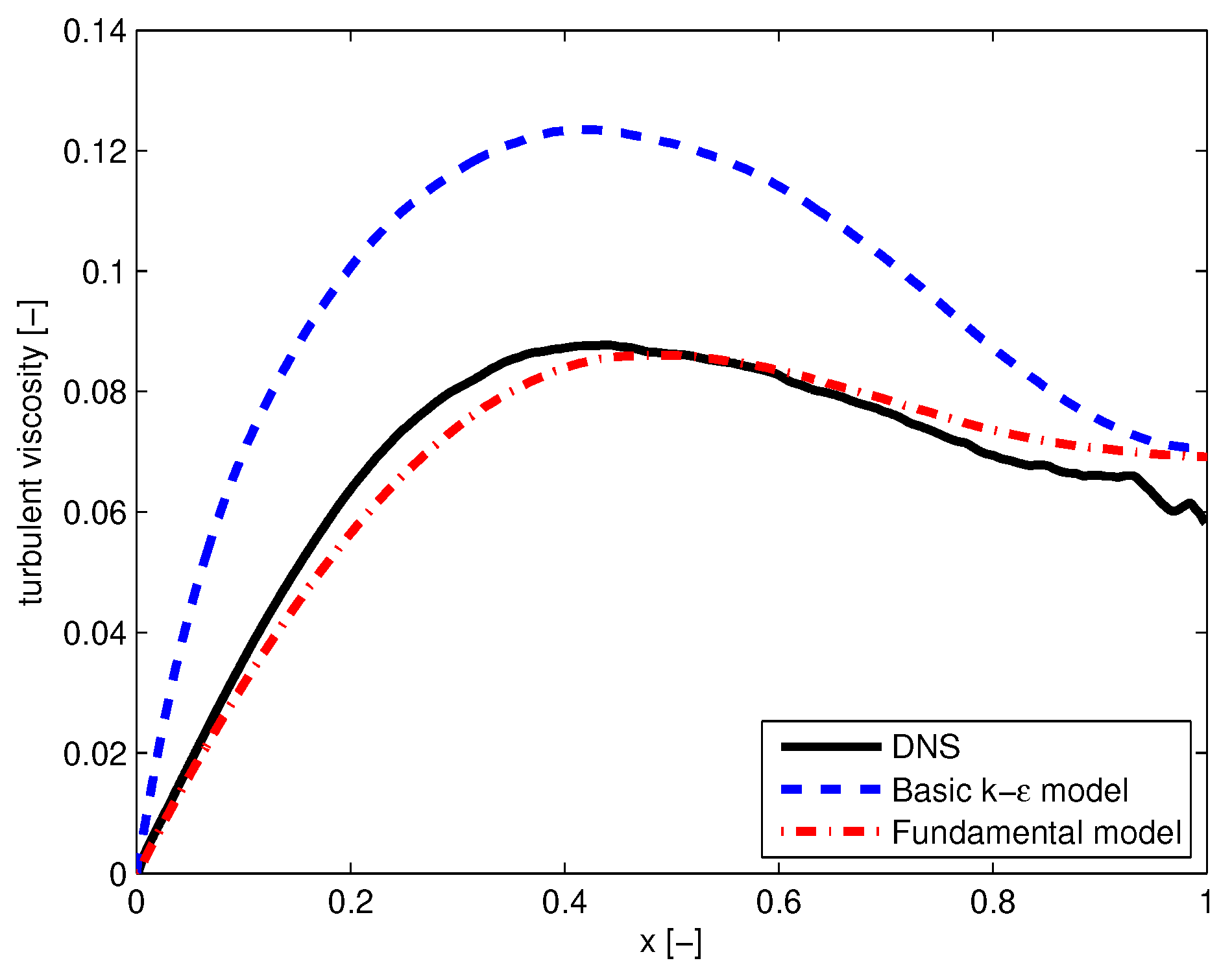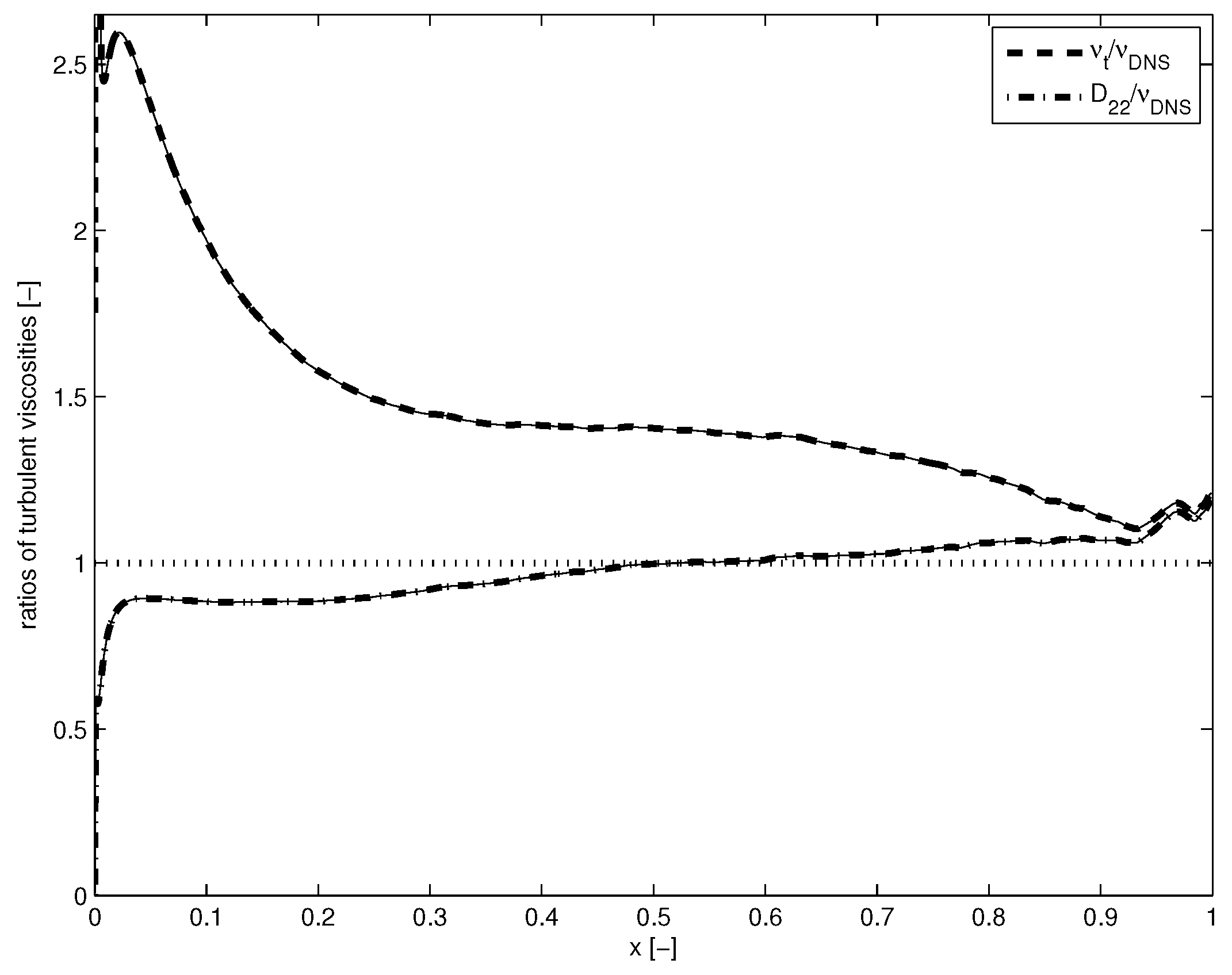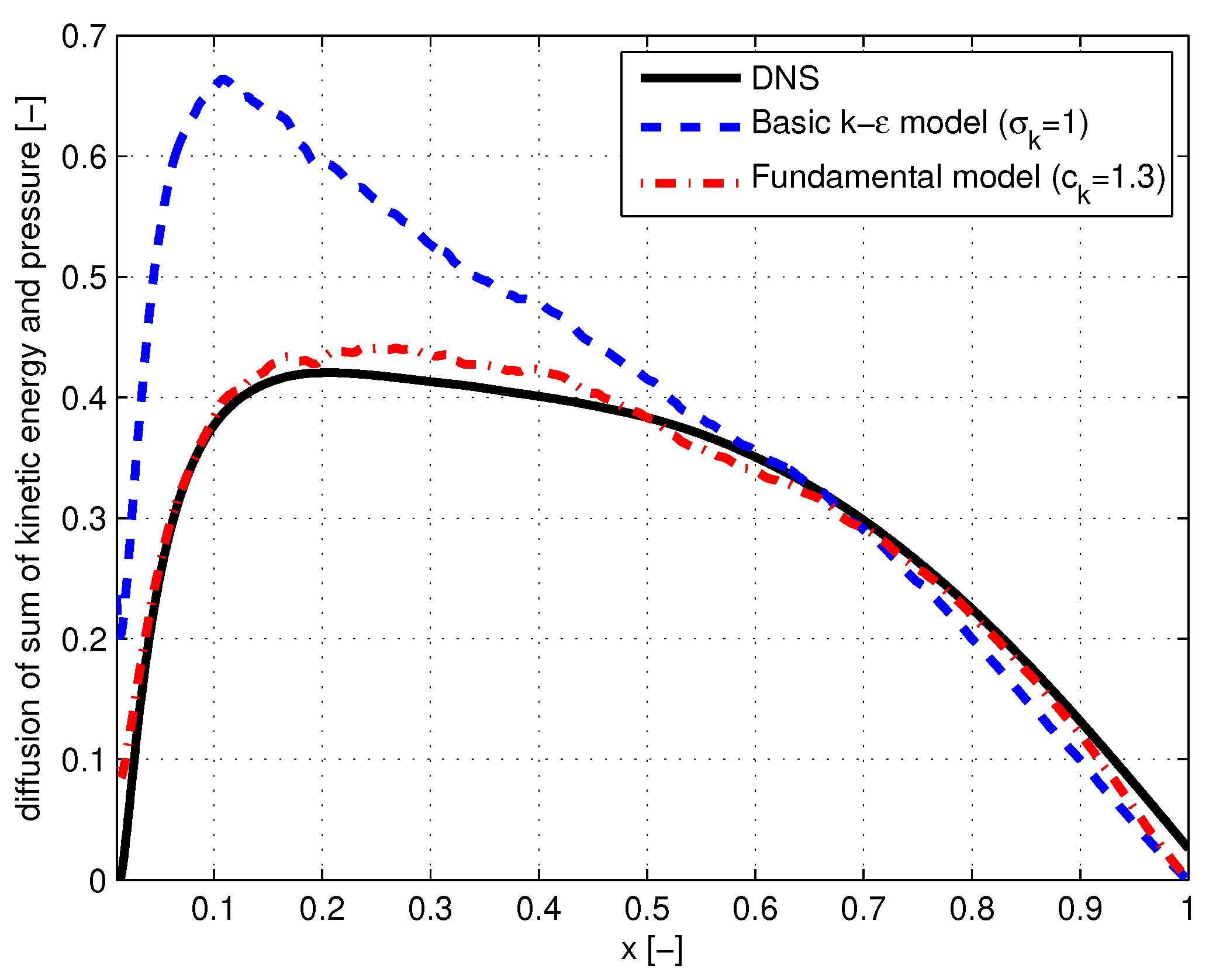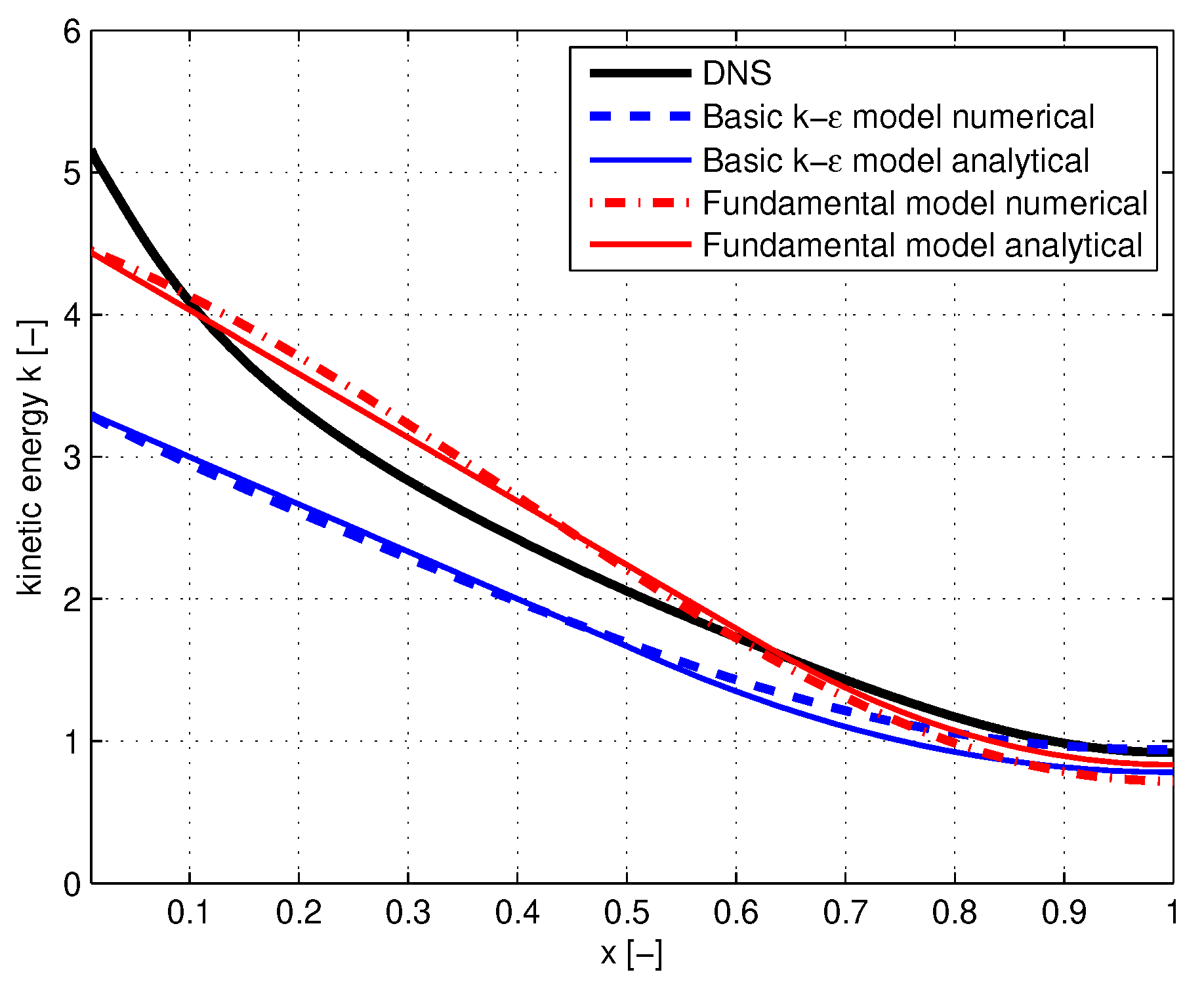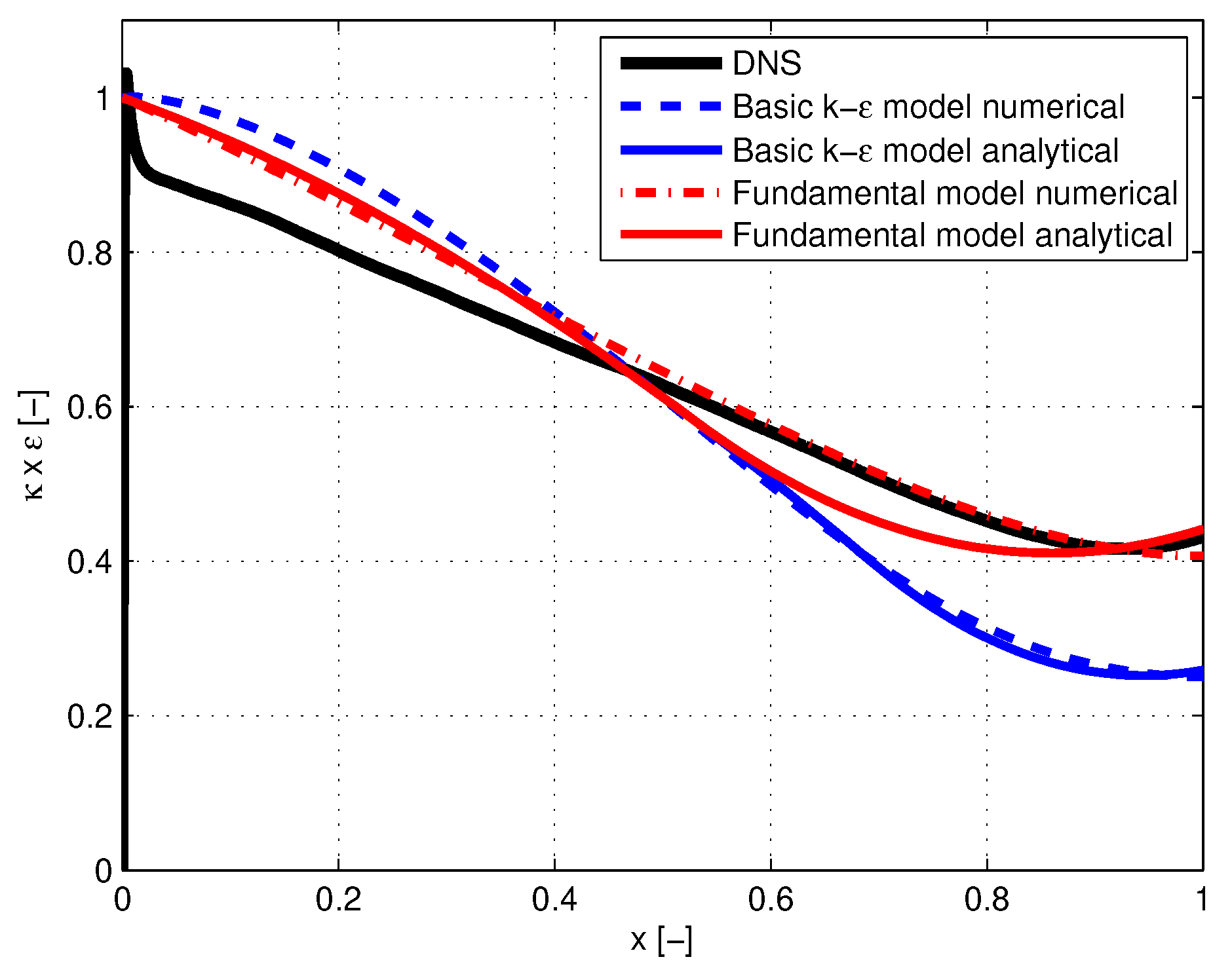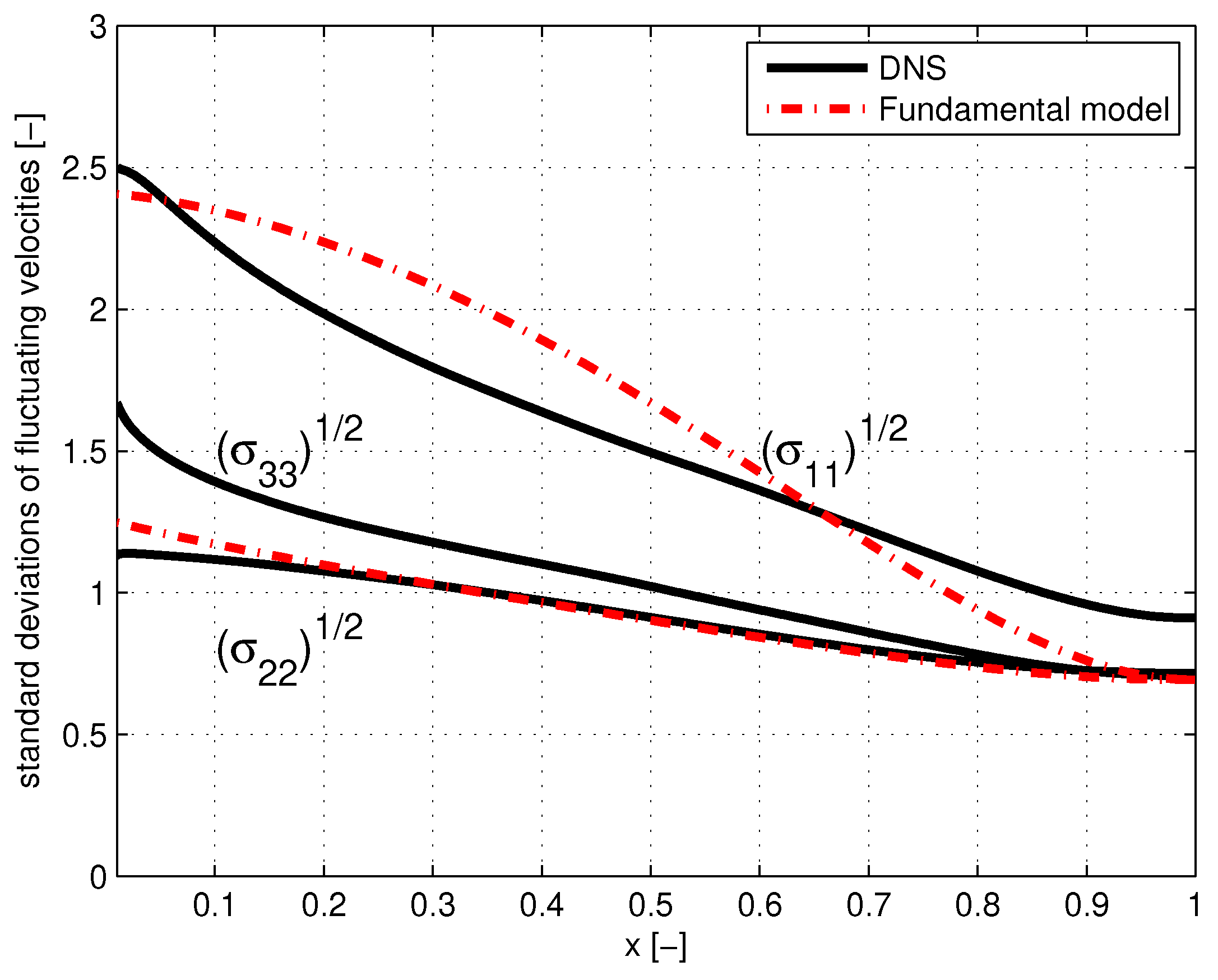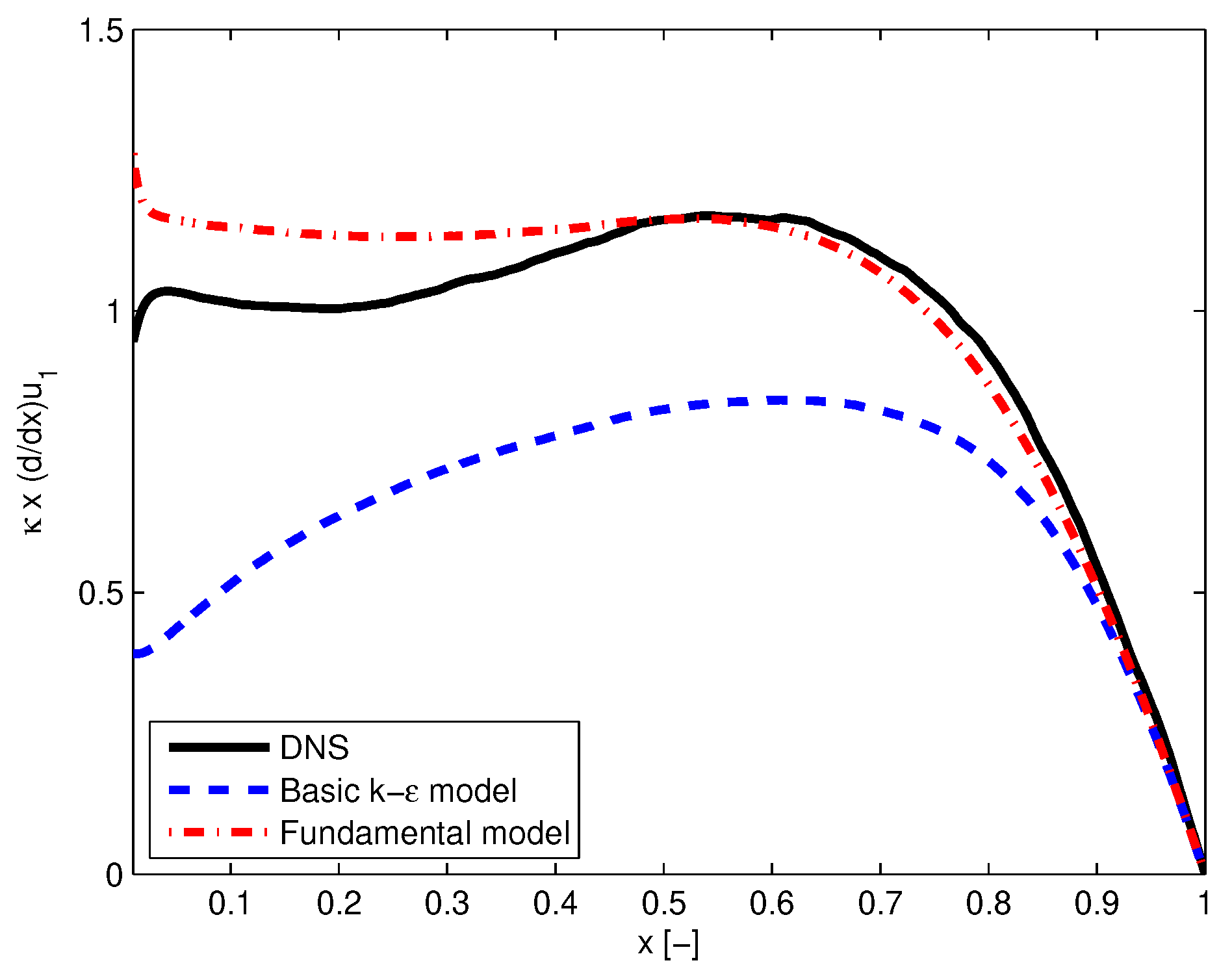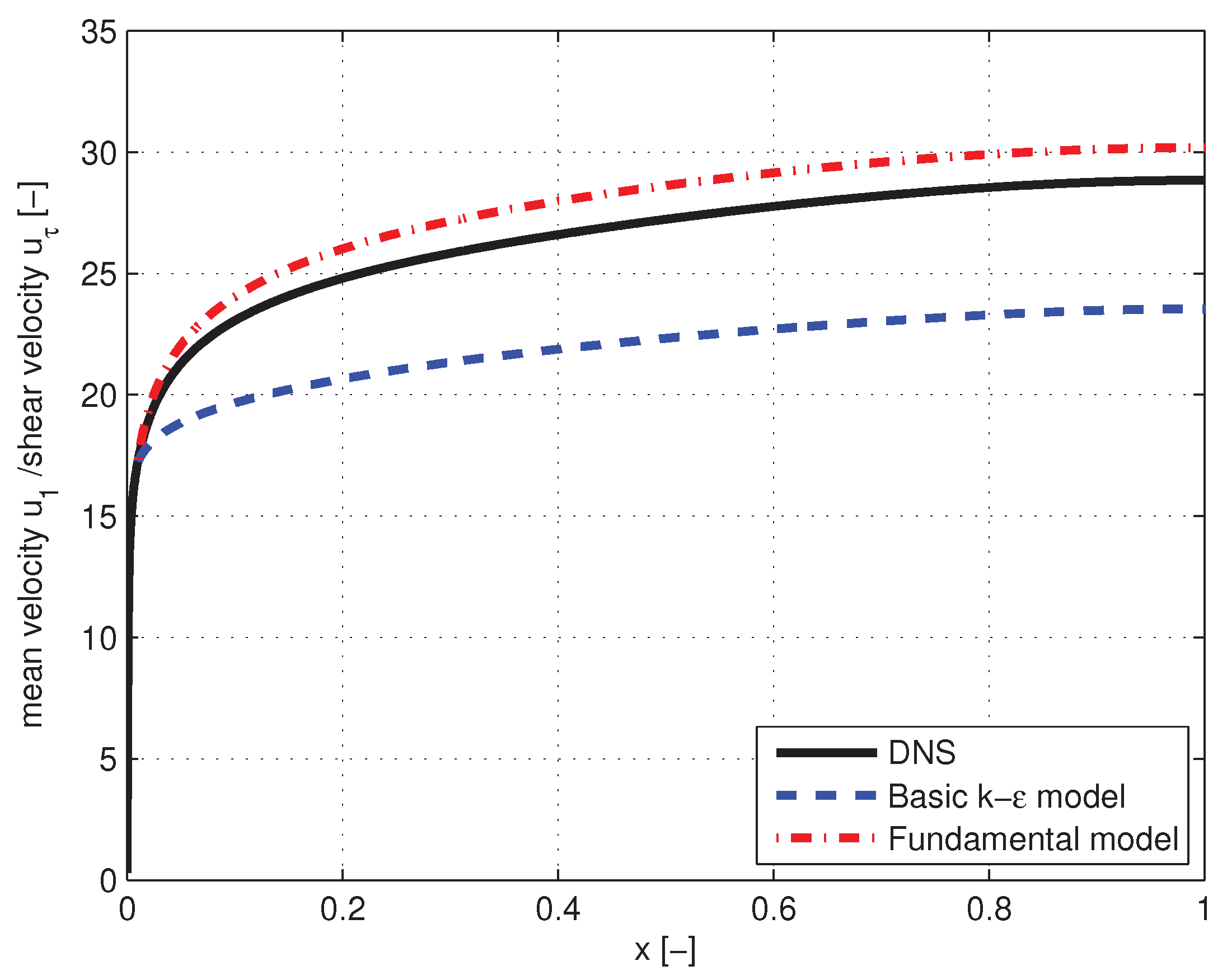1. Introduction
The description of turbulence has been an issue right from the beginning. A solid starting point for analysis are the Navier-Stokes equations which describe the flow. These can be time averaged resulting in equations for mean values of velocity, pressure and temperature. Problem are the average values of the products of the fluctuating quantities in the non-linear convection terms in the equations. They describe the effect of fluctuations on mean flow quantities. Proposed representations of average nonlinear convective fluctuations have been of a hypothetical nature by drawing analogies with molecular chaos. Boussinesq [
1] was the first to follow this line of thinking by introducing the gradient hypothesis: the averaged nonlinear fluxes are proportional to the derivative of the mean flow quantity proceeded by a constant termed turbulent viscosity or turbulent diffusion coefficient. Several versions and extensions based on the same idea have since then been put forward by the pioneers of turbulence theory: Taylor [
2], Prandtl [
3], and Von Karman [
4] among others. They form also the basis of many of today’s computer models used in engineering and environmental analysis: Hanjalic and Launder [
5], Bernard and Wallace [
6].
An offspring of the afore mentioned concept is the basic
k-
model widely used in engineering and environmental analysis [
5,
6]. The average value of momentum fluxes is described by the gradient of the mean velocity. Fluctuations are isotropic and the coefficient proceeding the gradient equals
where k is mean kinetic energy of fluctuations,
is mean energy dissipation rate and
is a calibration constant. The model is completed by equations for
k and
. The gradient hypothesis is also applied to several other flux terms in the equations with different values of the calibration constants.
Problem with the gradient based models is their hypothetical origin and lack of uniqueness. Starting from a sketchy analogy with laminar diffusion almost limitless forms of gradient representations and proceeding functional dependencies can be devised. A new development which surpasses these limitations is the statistical description of anisotropic inhomogeneous turbulence: Brouwers [
7,
8,
9]. Turbulence at high Reynolds number is featured by unstable eddies of whirling irregular fluid velocities whose behaviour is governed by domination of the inertial forces in the momentum balance: Monin and Yaglom, Vol. II, Ch.8 [
10]. The eddies start at sizes of the configuration and break down to ever smaller ones until the point where viscous forces become into play at sizes of a few millimeter. Here the theory of small viscous scales of Kolmogorov comes into play [
10]. Building on this framework of high Reynolds turbulence and using the methods of stochastic theory of Van Kampen [
11] and Stratonovich [
12] explicit statistical descriptions of governing variables are obtained. They are the leading terms of asymptotic expansions based on small value of the inverse of the universal Lagrangian Kolmogorov constant. Results represent unique descriptions of turbulent flow statistics up to deviations due to truncated higher order terms.
An opportunity for testing the outcome of the turbulence models is provided by the results of Direct Numerical Simulation DNS of the Navier-Stokes equations. With the evolution of modern computer power it has become possible to generate a wealth of accurate data on turbulent flow at high Reynolds number. Most interestingly are the recent DNS data of turbulent channel flow of Hoyas et all [
13,
14] and Kuerten et all [
15]. Fluctuating channel velocities are strongly fundamentally based and averages of flow quantities vary strongly with distance from the wall. Inhomogeneity and anisotropy are the characteristics of turbulence in practice. The DNS data thus provide a meaningful test case for models. In this paper a detailed comparison is presented of the DNS data with the predictions of the basic
k-
model and the new fundamentally based model, also referred to as fundamental model.
2. The Basic k- Model and the New Fundamental Model
Considered is turbulent flow of an incompressible fluid or an almost incompressible fluid, e.g. a liquid or a gas flowing at speeds where the square of the Mach number is small. The density is taken constant. Turbulent fluctuations measured at a fixed point in space are treated as a statistical process which is stationary or almost stationary in time compared to the time of velocity fluctuations. Statistical averages follow from time averaging over sufficiently long time intervals. The time averaged representation of the Navier-Stokes equations is given by
Conservation of momentum:
Conservation of energy:where angled brackets represent statistical averaging,
t and
x are time and space coordinate,
u,
p, and
are mean or time-averaged values of fluid velocity, pressure, and temperature and
and
represent fluctuations of velocity and temperature, that is velocity and temperature minus their mean value. As we are concerned with flow at high Reynolds number the contributions of the viscous forces and heat conductivity present in the Navier-Stokes equations have been dropped. Their effect can be disregarded when considering the main flow governed by instability of inviscid flow outside small boundary layers The average temperature in energy equation (
3) can also be used to describe the average distribution of passive or almost passive admixture in the fluid. Restricting the formulation of the conservation equations to an incompressible or almost incompressible fluid implies that the solution of (
1) and (
2) is not affected by the value of the conservative scalar temperature. The representation holds as long as the changes in temperature or admixture imposed at external boundary conditions are of limited magnitude.
2.1. Turbulent Diffusion in the Basic k- Model
The appearance of turbulent fluxes in the convection terms of the averaged conservation equations results in an unclosed set of equations for mean flow variables. It is known as the closure problem. To resolve this issue a diffusion hypothesis has been introduced in the basic
k-
model. In this hypothesis turbulent fluxes are treated as isotropic and are described by [
5,
6].
where
is a scalar which represents diffusivity or turbulent viscosity and which is defined by
and where
k is average kinetic energy of fluctuations,
and
is average energy dissipation rate with
being kinematic viscosity;
in (
4) and (
5) is a calibration constant whose value is usually taken as
[
5,
6]. In Equation (
5) correction factors are sometimes added to the diffusion constant, i.e. a turbulent Prandtl number and a turbulent Schmidt number in case of temperature and admixture respectively. But these numbers are generally close to unity and are omitted here.
2.2. Turbulent Diffusion in the Fundamentally Based Model
The derivation of the fundamental model starts from a Langevin equation for fluid particle velocity [
8,
9,
10]. In this equation the limiting form of Kolmogorov’s theory of small scales is implemented, i.e. the limiting form of this theory when times characteristic for the velocity fluctuations are much larger than the time of the viscous scales. This is the case when the Reynolds number is large: Kolmogorov [
16]. A further step is an expansion in terms of the inverse of the Kolmogorov constant
. Matching predictions with data of measurements and DNS reveals values of
around
; in the present analysis a value of 7 is adopted. Furthermore the area where the Lagrangian description applies can be reduced to a point in the Eulerian flow description in the limit of small
. In this way Lagrangian based descriptions are connected to Eulerian ones. The following descriptions for the flux terms are obtained [
8,
9]
where the fundamentally based diffusion tensor
is described by
and
is co-variance or Reynolds stress. Relations (
8) - (
10) are part of the description which holds in the entire flow configuration (except from the thin viscous layers at walls) once they are coupled to conservation equations (
1) - (
3). In this way change of turbulent flux at each point x as described by (
7) and (
8) is connected to change in kinetic energy and energy dissipation. Although the presence of
in the expression for energy dissipation
may suggest otherwise,
is a characteristic of the main inviscid flow outside the boundary layers [
10]. The magnitude of gradients of velocity is governed by the small viscous scales of turbulence. It scales as
and makes the magnitude of
independent of
. This independency is reflected in the equations for
k and
presented in the next section.
The above expressions for diffusion of the fundamental model reveal dependency on mean gradients which are of a more complex structure than those of the basic k- model. It reflects the anisotropy of the fluctuating velocity field and reveals a more complex dependency of flow statistics.
Application of the fundamentally based diffusion approximation to a scalar as done in Equation (
8) is only justified if the scalar is a conservative scalar [
8,
9]. The value of the conservative scalar is constant when following a fluid particle and fluctuates in value in a fixed coordinate system only due to fluctuations of the fluid particle. This is the case for temperature in an incompressible fluid such as liquids. It is approximately correct if the fluid is almost incompressible as is the case in gases flowing at speeds where the square of the Mach number is small. The scalar representation can also be applied to passive or almost passive admixture in fluids such as aerosols in air [
7,
8,
9]. It leads to errors when applied to non-conservative scalars such as kinetic energy and pressure: see section 5.
3. Equations for k and
Implementing the expressions for turbulent diffusion of the basic
k-
model and the fundamental model in the averaged conservation equations introduces two unknowns: the mean kinetic energy
k and the mean energy dissipation rate
. Equations for
k and
can be obtained from the Navier-Stokes equations [
8,
9]. Our aim is to describe the flow away from thin viscous controlled layers near walls being in size a few millimeters only. In line with this approach the contributions in the equations for
k and
from laminar viscosity will be disregarded ( just as we did in conservation equations (
1), (
2) and (
3)). To provide boundary conditions at the wall the viscous layer is surpassed by applying the solutions of the log layer at
: [
5,
6].
The equation for
k reads as [
5,
6]
where P is mean production of turbulent fluctuations defined by
and where
and
are the fluctuating parts of kinetic energy and pressure, respectively, that is the kinetic energy and dissipation rates minus their time-averaged values. There are two turbulent flux terms in Equation (
11), i. e. the third and fourth term on the LHS of (
11), which need to be modelled. In the basic
k-
model both terms are lumped together [
5,
6] and are described by:
where
is a calibration constant which is usually taken unity:
[
5,
6].
The theory underlying the fundamental model provides general expressions for turbulent scalar fluxes which are free from calibration factors. However, these expressions are only valid for conservative scalars and lead to disagreement with DNS results when applied to turbulent fluxes of kinetic energy and pressure [
8]. A fall back to empirical construction is needed. It reads as
where it is noted that if
k were a conserved scalar its diffusion should be described by
. The factor
represents correction for non-conservative behaviour and includes the relative small contribution [
8] of pressure diffusion. The above relations for diffusion of kinetic energy and pressure will be compared and calibrated with DNS results in
Section 5.
The equation for
conventionally applied in CFD models [
5,
6] is largely an empirical construction. Its basic
k-
form follows from the Navier-Stokes equations. It contains a number of terms which are governed by the small viscous scales. These terms are generally replaced by expressions which meet the criteria of matching to the results of decaying grid turbulence and the log layer of turbulent channel flow. The equation reads as
Fundamental modelThe constant
ensures matching with the case of grid turbulence. Its value is usually taken to be
which is somewhat less than the theoretical limit value of 2 for infinite Reynolds number: George [
17]. The von Karman constant
is equal to
. In case of the basic
k-
model the calibration constant
is usually taken to be around
and
is specified by the equation (eq. (8.41) of [
16])
The values appropriate for
and
in case of the fundamental model are determined in section 6.
4. Channel Flow
Objective is to compare the results of the basic
k-
model and the fundamental model with those of DNS of channel flow. The channel consists of parallel planes in between which the mean velocity
is unidirectional in the direction
parallel to the planes. Its magnitude and the value of statistical averages related to velocity fluctuations only change in the direction
normal to the planes. For channel flow there is an exact solution for the mean pressure [
9] which reads as
where
is shear velocity and
is channel height. The shear velocity is determined by the pressure drop in direction
at given
. There are theoretical and experimentally confirmed relations for the relationship determining
. Another exact result for channel flow is the description of the co-variance
or
.
which is valid outside the thin viscous layer at the wall [
9].
In the subsequent analysis of channel flow we shall make use of dimensionless formulations:
is made dimensionless by
,
and
by
,
and
by
H,
P and
by
; the subscript
2 of
will be dropped. In this new notation Equations (
18) and (
19) become
which is valid outside the thin viscous layer at the wall.
Furthermore Equation (
12) becomes
The above solutions follow from the averaged momentum equations adopted to the case of channel flow [
9]. A complete specification of all variables follows from the expressions for turbulent fluxes and the equations for
k and
. In case of channel flow these reduce to:
Fundamental model:
In the subsequent sections we shall compare the above descriptions with results of DNS.
5. Testing the Diffusion Representations by DNS
In the derivation of equations for the mean values of flow quantities use has been made of the diffusion representation of mean fluxes, i.e. the mean value of products of fluctuating quantities. Their correctness and accuracy will be assessed by comparison with DNS results published for friction Reynolds numbers
of 950 [
15], 2000 [
13] and
[
14]. The comparison is focussed on the flow in the main region, the region outside the thin boundary layer at the wall. In the main region flow statistics are governed by unstable large eddies governed by inertia forces while the effect of viscosity in this region is negligibly small. The presented basic
k-
and fundamental model intend to describe these statistics. The boundary layer is governed by viscous forces and is situated in the region
, that is,
and
for
and
respectively. The DNS results of the boundary layer near
are omitted in this analysis.
5.1. Diffusion of Momentum
In case of channel flow turbulent momentum transport is apparent in the equation
where
is turbulent viscosity according to the DNS results, that is the value calculated from eq. (
25) when substituting the values of
and
obtained from DNS data. The value according to the basic
k-
model
is given by Equation (
6) and that according to the fundamental model
by Equation (24g) whereby the RHS’s of these equations are evaluated from the DNS data. The DNS data which were used are those of
[
14]. The three turbulent viscosities thus calculated have been shown as a function of
x in
Figure 1. The ratios
and
versus
x have been shown in
Figure 2. Disregarding the thin viscous layer at the wall, the fundamental model gives satisfactory agreement over the entire
x range without the use of calibration factors. Deviations are less than
from the DNS results. They can be ascribed to truncation of the higher order terms in the expansions in powers of
which were used in the theory leading to the presented expressions [
8,
9]. The same conclusion was arrived at when using the DNS data of
[
9,
13]. The basic
k-
model on the other hand disagrees quite a lot from DNS. The disagreement is largest at small x and gradually becomes smaller when approaching the central axis of the channel:
. The dependency on
x is apparently not well captured by representation (23d), in contrast with (24g) which shows satisfactory agreement over the entire range.
5.2. Diffusion of Temperature
Temperature is a conservative quantity in incompressible flow at high Reynolds number where heat conductivity by molecular vibration is negligibly small outside thin layers at the walls. From the theory underlying the fundamental model it follows that the thermal diffusion constant equals
: cf. eq.(
8). In case of channel flow it becomes
and becomes equal to that of turbulent viscosity: cf. Equations (24d)–(24e). This result is confirmed by Lagrangian based DNS of channel flow at
[
15] where the thermal diffusion coefficient according to DNS,
is compared to that of the fundamentally based model
.The agreement closely resembles that shown in
Figure 1 and
Figure 2, c.q.,
and
. Deviations of the predictions of the basic
k-
model are likely equally large as those shown in
Figure 1 and
Figure 2.
5.3. Diffusion of Kinetic Energy and Pressure
In the case of the basic
k-
model fluxes of kinetic energy and pressure are lumped together: Equation (
13) For channel flow these become
From eq.(
14) we have for the fundamental model
The description is used in the numerical solution of the equation for
k in
Section 6.
In
Figure 3 we have shown the sum of both fluxes versus
x when the RHS’s of (
26) and (
27) are evaluated by the DNS data. Values for the calibration constants
and
of 1 and
were taken. Also is shown the value of the sums obtained by direct calculation of their values using DNS of
. The empirical construction of Equation (
27) based on the fundamental model gives surprisingly good agreement. The agreement extends over the entire
x-range and is obtained with the calibration constant
.
5.4. Diffusion of Energy Dissipation
DNS data do not provide information of average values of products of velocity fluctuations and dissipation fluctuations. Direct verification of the diffusion representation is thus not possible. Further, the differential equation for mean energy dissipation in both models is largely an empirical construction. What is still possible is to verify the values of quantities obtained from the solutions of the coupled differential equations for mean kinetic energy and mean energy dissipation with the DNS data. This is the subject of the next section.
6. Solutions of k and Compared with DNS
In the previous section predictions of individual components of the models were verified by DNS. Further testing is executed by comparing numerically obtained solutions of the model equations as a whole with DNS.
6.1. Equations and Boundary Conditions
Model equations are given by coupled differential equations for mean kinetic energy and mean energy dissipation. For mean energy dissipation the variable G is introduced which is defined by
Near the wall outside the viscous layer solutions should comply with the solutions of the log layer. Inertial subrange asymptotics [
18] reveal that production
P and dissipation
are equal in this region:
. Furthermore,
so that
. DNS results show values of
G in the log layer which are between
and 1 [
13,
14]. In the present analysis the theoretical value of 1 is taken. Making use of relations (
21), (23b), (23d) and (
28) differential equations (23e) and (23f) can be transformed into the following coupled equations for
k and
G appropriate for the basic
k-
model.
where
where values of the empirical constants will be taken in agreement with [
5,
6]:
,
,
,
,
,
. The boundary conditions are
The boundary condition for
k at
follows from relations (
21) (23b) and (23d) noting that
in the log layer. The boundary condition for
G at
corresponds to zero slope of
at
.
The equations appropriate for the fundamental model follow from (24h) and (24i) upon using (
28), (
21), (
24a)–(24g).
and
In these equations
k and
are related to each other by an algebraic relation which is obtained by systematic elimination of
,
,
,
,
,
from Equations (
21), (
24a) and (24g)
The relation can be used to eliminate
from (
34)–(
35) resulting in two differential equations for
k and
G. However, analysis of the above relation for
k shows that in an area close to
according to (
37)
can have two values for one value of
k. Verification of (
37) using the results of DNS confirms the correctness of the equation and the double dependency in this area. The other way around is not the case: for each value of
there is only one value of
k possible. The easiest approach is then to substitute for
k relation (
37) into the two differential equations (
34) and (
35) and solve for
and
G. The value of
k is subsequently obtained from (
37). The boundary conditions are
where the boundary condition for
at
follows from Equations (
21), (24d) and (24g) noting that
in the log layer. As in the basic
k-
model
. A value of
of
was established in
Section 5.3 (
Figure 3). A value of
of
is found to lead to the best agreement with DNS.
The value of
follows from Equation (
35) by letting
x approach
. It yields the relation
which is analogous to eq.(
17) in case of the basic
k-
model;
is the value of
k at
obtained from eq.(
37). For
,
,
and
,
. This suggests negative production. However, for the first term on the LHS of eq.(
35) one can write
where the last two terms have the same character as that of production and make the total of production-like-terms positive.
6.2. Numerical Solution
Numerical instability is encountered when solving Equations (
29)-(
30) and (
34)-(
35), a feature not uncommon for
k-
equations: Lew et all [
19]. Way out is to convert the equations into a diffusion problem by adding the terms
and
on the RHS of (
29)-(
30),
and
on the RHS of (
34)-(
35) and solving starting from a suitably chosen initial solution at
: Borse [
20]. After sufficient time the solution has converged to the desired stationary result.
Another difficulty encountered in the execution of the numerical calculations concerned the boundary condition for
G at
: cf. Equations (
33) and (
39). These were replaced by
at
. The effect of this simplification is limited to a small region near
.
In
Figure 4 and
Figure 5 are respectively shown the distributions versus
x of kinetic energy
k and energy dissipation rate
G according DNS, according the basic
k-
model calculated from Equations (
29) - (
30) and according to the fundamentally based model calculated from Equations (
34) - (
35).
6.3. Analytical Solution
Distinction is made between the area near the wall referred to as outer region and the area near the centre of the channel referred to as inner region. The outer region is the area where production and dissipation of energy are dominant. Turbulent diffusion of kinetic energy and pressure and turbulent diffusion of dissipation are negligibly small. It is the area where the log layer description for mean flow applies and where production equals dissipation [
21]. In the inner region turbulent diffusion of kinetic energy and pressure and turbulent diffusion of dissipation are important and in balance with energy dissipation while production is negligibly small. For each of these regions analytical solutions can be derived which are subsequently matched to arrive at a complete solution.
6.3.1. Solutions for k and G in the Outer Region
Solutions valid in the outer region are obtained by retaining the second and third term in eqs.(
28) and eqs.(
33) yielding
and
or in terms of
k and
Fundamental model:Using the relation between
k and
at
according to the fundamental model, cf. Equation (
37), we have
where
is the value of
k at
which amounts to
for
. To derive the equations for
G applicable in the outer region the second and third term of Equation (
41) need to be taken into account (and replacing
B by
A in Equation (
41) in case of the basic
k-
model). Noting that in the outer region
and
one obtains for
G from Equation (
30) using relation (
17) and from Equation (
35) using relation (
40) the result
The above descriptions for k and G are rather simple, They compare well with the numerical results for values of x up to about . At greater distances from the wall they start to deviate and fail to meet the conditions of zero slope at . To overcome this deficiency solutions valid for the inner region are developed.
6.3.2. Solutions for k in the Inner Region
Solutions for
k are developed by describing
k by a series of successive powers of
. The linear term in
is omitted in order to satisfy the zero-slope condition at
. Disregarding terms of
and higher we write for
k
where
is the value of
k at
;
and
a are to be determined. Substituting expression (
47) in Equation (
29) and (
34) and equating the leading terms of
we obtain for
a in case of the basic
k-
and fundamental models respectively the relations
and
where
is the value of
G at
. In deriving result (
49) we took for
at
the value
in accordance with Equation (
37). The boundary between inner and outer region is defined by
. At this boundary the value of
k and its slope should match the values according to those of the outer region. This yields the relations:
for basic
k-
and fundamental model respectively. From Equations (
47)-(
51) the following solutions are obtained:
and for the fundamental model
The above solution parameters can be determined by implementing the values of the system parameters
and
. The value of
is taken from the numerical results:
in case of the basic
k-
model and
in case of the fundamental model. An alternative approach to determine
is to couple the above analytical solution of
k to that of
G presented in
Section 6.3.3 below. It yields values for
without recourse to the numerical results. The values are practically equal to those of the numerical results.
A complete analytical description of
k for outer and inner region is obtained from Equations (
41) and (
44) when
and Equations (
47) and (
52) when
where
in case of the basic
k-
model and
in case of the fundamental model. The result has been shown in
Figure 4 by solid blue and red lines.
6.3.3. Solutions for G in the Inner Region
For
G in the inner region the following expansion is used
where the linear term
is introduced to satisfy the boundary condition at
: cf. Equations (
33) and (
39). The values of
and
a are to be determined. Substituting description (
54) into Equations (
30) and (
35) and equating the leading terms of
yields
where
and
for basic
k-
model and fundamental model respectively. At the boundary of inner and outer region
the values of
G and its slope according to outer and inner regions should become equal. It yields the relations
Eliminating
from the above equations yields the following irreducible equation for
The value of
follows from Equation (
56) using the system values for the various parameters and taking for
the value of the numerical calculations, i.e.
, with the result that
and
in case of the basic
k-
model and the fundamental model respectively. By iteration one finds from eqs (
60) for the basic
k-
model
and for the fundamental model
. A complete analytical description of
G for outer and inner region is obtained from Equation (
46) when
and Equations (
54)-(
56) when
. The result has been shown in
Figure 5 by solid blue and red lines.
6.4. Discussion of Results
Numerical and analytical solutions for kinetic energy
k and energy dissipation
, the latter in terms of
, have been developed for the basic
k-
model and a new fundamentally based model. The solutions were compared with DNS results and have been shown in
Figure 4 and
Figure 5. Conclusions are:
Analytical solutions agree in a satisfactory manner with numerical solutions. The analytical solutions reveal the relative contributions of turbulent diffusion, energy production and energy dissipation in outer and inner region of the channel. They show to what extent the descriptions are empirically or fundamentally based and depend on calibration factors.
Solutions for k in the in the outer region according to the fundamental model do not depend on calibration constants. They have a fundamental basis. The differences with DNS can be ascribed to errors as a result of truncation in the expansion with respect to which underlies the fundamental model.
Solutions for k in the inner region according to the fundamental model depend on the calibration factor .
Solutions for k in both the outer and inner region according to the basic k- model depend on the calibration factors and .
Solutions for G in the outer region according to the fundamental model and the basic k- model, and do not depend on calibration factors. Differences with DNS are due to some deviation between the value of production and dissipation in this area.
Solutions for G in the inner region according to the fundamental model and the basic k- model, and respectively, depend on the calibration factors and .
Using standard calibration constants in the solutions of the basic
k-
model results in notable deviations compared to DNS. The deviations can be reduced by recalibrating
,
and
. Deviations between diffusion constants remain significant because of different functional dependencies:
Figure 1,
Figure 2 and
Figure 3.
7. Velocity Distributions
The basic
k-
model is based on the assumption of an isotropic turbulence field. It cannot predict anisotropic behaviour of co-variances or turbulent stresses. In case of the fundamental model the distribution of
follows from the solution of eqs.(
34) According to Equation (24b)
while
where
k is given by Equation (
37). In
Figure 6 the distribution versus
x is shown of the calculated values of the standard deviations of the fluctuations
,
and
according to the fundamental model and the results of DNS. Deviations are similar to those shown in [
9] and are ascribed to truncation of the expansions of
which underlies the theory of the fundamental model. Deviations of the three variances
from
k which describe anisotropy are next to leading order in the
expansion (cf. Equation (
24a) - (24c)) and therefore more sensitive to truncation error.
For the gradient of the mean flow the following relations can be derived. For the basic
k-
model from eqs (
21) and (23b)
For the fundamental model from eqs (
21) and (24d)
In
Figure 7 the distributions versus
x are shown of
according to DNS, the basic
k-
model and the fundamental model. The deviations between DNS and basic
k-
model are similar to those shown for
and
shown in
Figure 1 and
Figure 2. Similarly the agreement between
and
shown in
Figure 1 and
Figure 2. According to (
21):
which indicates that disagreement of production with DNS in case of the basic
k-
model is similar to that shown in
Figure 7 and that agreement of production with DNS in case of the fundamental model is similar to that shown in
Figure 7.
The distribution of mean velocity
predicted by the basic
k-
model and the fundamental model are obtained by integration of the RHS’s of Equations (
61) and (
62). Because the models do not describe the velocity in the viscous layer at the wall the integration starts at some distance from the wall for which the position
is taken. The value of
at this point according to the DNS results of
is 17.2 which agrees with the values obtained from measurements: Monin and Yaglom, Vol. I, fig. 25 [
21]. The results of the integration are shown in
Figure 8, where the distributions of mean velocity of the two models and of DNS are presented. It is seen that for equal shear velocity, that is for equal longitudinal pressure gradient in the channel, the fundamental model somewhat overestimates mean velocity, by
while the basic
k-
model underestimates by
.
8. Conclusions
An analysis has been presented of two models for determining mean values of turbulent flow variables: velocities
, pressure
p, turbulent diffusion
, kinetic energy
k and energy dissipation
. The two models are the basic
k-
model widely used in engineering applications and environmental analysis [
5,
6], and a new fundamentally based model which is derived from recently published statistical descriptions of inhomogeneous anisotropic turbulence [
7,
8,
9]. The analysis was focused on turbulent channel flow which is highly anisotropic and inhomogeneous. It is of direct relevance to applications of duct flows, turbulent boundary layers around bodies and the atmospheric surface layer around the earth. Model predictions were verified against published results of direct numerical simulations DNS for shear Reynolds numbers of 950 [
15], 2000 [
13] and
[
14]. The comparison was focussed on the regions outside the thin viscous boundary layers of a few millimeters at the wall. The development status of DNS is mature; its results can serve as a reliable source for verifying model predictions.
The basic
k-
model is built on an empirical isentropic representation of the turbulence field. It contains a gradient hypothesis for turbulent diffusion which is supplemented by calibration constants. Using conventionally proposed values for the calibration constants [
5,
6] model predictions of several variables are found to deviate remarkably from the results of DNS. A summary has been given in
Table 1.
The fundamental model is derived from a theory which has a fundamental basis [
7,
8,
9]. Expressions for turbulent diffusion of momentum and of conservative scalars such as temperature and passive admixture (smoke, aerosols) are of a general nature. They are free from calibration constants. They are found to agree in a satisfactory manner with DNS results at all distances x from the wall (outside the thin boundary layer at the wall). The theory underlying the fundamental model does not provide generally valid expressions for turbulent diffusion of the non-conservative scalars kinetic energy, pressure, energy dissipation. The non-conservative diffusion terms are only important for the determination of
k and
in the inner half of the channel. Here non-conservative behaviour has been modeled by using the diffusion expressions of conservative scalars provided with calibration factors. A summary is given in
Table 1.
A general limitation of empirical models is that they lack a fundamental basis. It is uncertain whether the modelled terms are correctly described by their dependencies on variables. The addition of calibration factors tempers inaccuracies of prediction to some extent. At the same time they need to be specified for each new case. Models which are derived from generally valid principles do not suffer from these limitations. The presented fundamental model contains descriptions of several variables which satisfy this criterion. Calibration factors are absent and applicability can be expected to exceed that of channel flow. What is still missing in the fundamental model are fundamental expressions for non-conservative scalars. Their development eliminates the remaining empirical factors.
Funding
This research received no external funding.
Informed Consent Statement
Not applicable.
Data Availability Statement
Not applicable.
Acknowledgments
B.G.J. Ruis and H.S. Janssen are acknowledged for performing numerical calculations; G.M. Janssen for preparing the manuscript.
Conflicts of Interest
The author declares no conflict of interest.
References
- Boussinesq, J. Mem.pres.par.div. savantis a l’acad. sci. de Paris, 1877, 23, 1, 1-680, 1877, 24, 2, 726-736.
- Taylor, G.I. Phil.Trans. 1915, A215, 1-26, and Proc.Roy.Soc.(London), 1932, A135, 685-701.
- Prandtl, L. Zeits. f. Math.u. Mech., 1925, 5, 136-139.
- Karman, Th. von. Nachr. Ges. Wiss. Goettingen, Math. Phys., 1930, Klasse 58-76.
- Hanjali´c, K.; Launder, B. Modelling Turbulence in Engineering and the Environment: Second-Moment Routes to Closure; Cambridge University Press: Cambridge, UK, 2011. [Google Scholar]
- Bernard, P.S.; Wallace, J.K. Turbulent Flow: Analysis, Measurement and Prediction; Wiley: New Jersey, NJ, USA, 2002. [Google Scholar]
- Brouwers, J.J.H. Statistical description of turbulent dispersion. Phys. Rev. E Stat. Nonlinear Soft Matter Phys. 2012, 86, 066309. [Google Scholar] [CrossRef] [PubMed]
- Brouwers, J.J.H. Statistical Models of Large Scale Turbulent Flow. Flow Turbul. Combust. 2016, 97, 369–399. [Google Scholar] [CrossRef]
- Brouwers, J.J.H. Statistical Descriptions of Inhomogeneous fundamentally based Turbulence Mathematics 2022, 10, 4619.
- Monin, A.S.; Yaglom, A.M. Statistical Fluid Mechanics, Vol II, Ch 8; Dover: New York, NY, USA, 2007. [Google Scholar]
- van Kampen, N.G. Stochastic Processes in Physics and Chemistry, 3rd ed.; Elsevier: New York, NY, USA, 2007. [Google Scholar]
- Stratonovich, R.L. Topics in the Theory of Random Noise; Gordon and Breach: New York, NY, USA, 1967; Volume 1. [Google Scholar]
- Hoyas, S.; Jiménez, J. Scaling of the velocity fluctuations in turbulent channels up to Re_τ=2003. Phys. Fluids 2006, 18, 011702. [Google Scholar] [CrossRef]
- Hoyas, S.; Oberlack, M.; Alcántara-Ávila, F.; Kraheberger, S.V.; Laux, J. Wall turbulence at high friction Reynolds numbers. Phys.Rev. Fluids 2022, 7, 014602. [Google Scholar] [CrossRef]
- Kuerten, J.; Brouwers, J.J.H. Lagrangian statistics of turbulent channel flow at Re_τ=950 calculated with direct numerical simulation and Langevin models. Phys. Fluids 2013, 25, 105108. [Google Scholar] [CrossRef]
- Kolmogorov, A. The Local Structure of Turbulence in Incompressible Viscous Fluid for Very Large Reynolds’ Numbers. Akad.Nauk. Sssr Dokl. 1941, 30, 301–305. [Google Scholar]
- George, W.K. The Decay of Homogeneous Isotropic Turbulence. Phys.Fluids A 1992, 4, 1492–1509. [Google Scholar] [CrossRef]
- Brouwers, J.J.H. Dissipation equals Production in the Log Layer of Wall Induced Turbulence. Phys.Fluids 2007, 19(10), 101702. [Google Scholar] [CrossRef]
- Lew,A.J.; Gustavo, C.; Carrica,B.; Carrida, P.M. Int. J. Computational Fluid Dynamics. 2001,14:3, 201-209. [CrossRef]
- Borse,G.J. Numerical Methods with Matlab, Ch.22, PWS Publishing, Boston, USA, 1997. ISBN 0534938221.
- Monin, A.S.; Yaglom, A.M. Statistical Fluid Mechanics, Vol I. Dover: New York, NY, USA, 2007.
|
Disclaimer/Publisher’s Note: The statements, opinions and data contained in all publications are solely those of the individual author(s) and contributor(s) and not of MDPI and/or the editor(s). MDPI and/or the editor(s) disclaim responsibility for any injury to people or property resulting from any ideas, methods, instructions or products referred to in the content. |
© 2024 by the authors. Licensee MDPI, Basel, Switzerland. This article is an open access article distributed under the terms and conditions of the Creative Commons Attribution (CC BY) license (http://creativecommons.org/licenses/by/4.0/).
